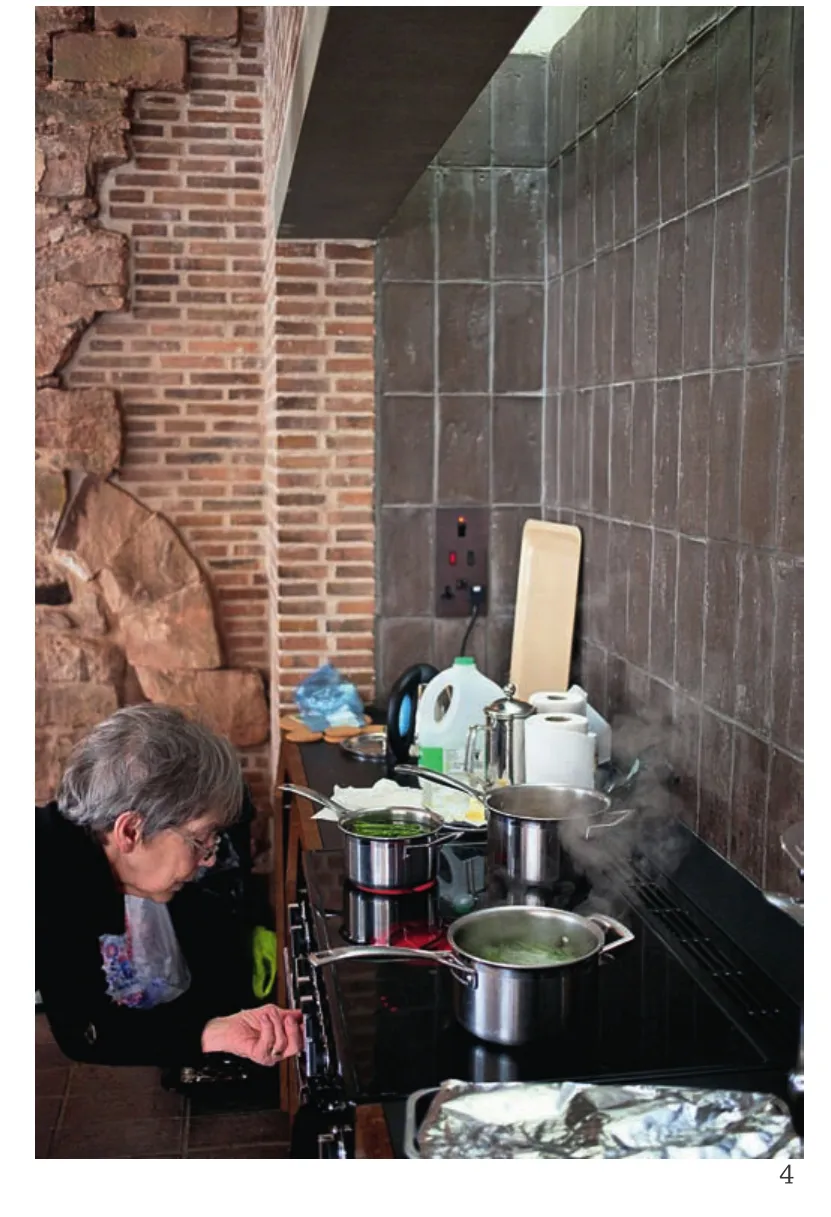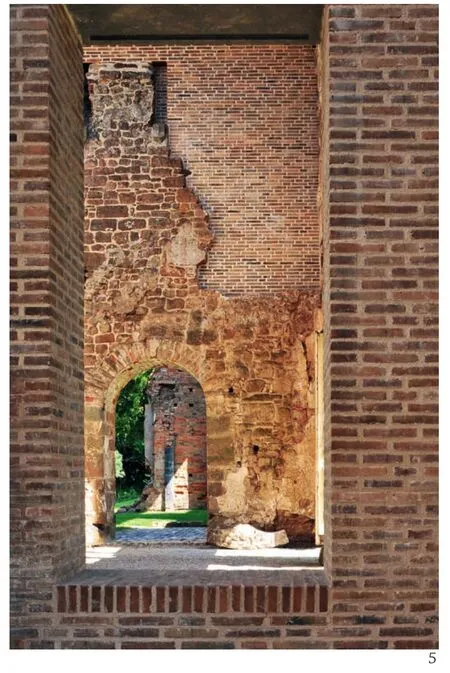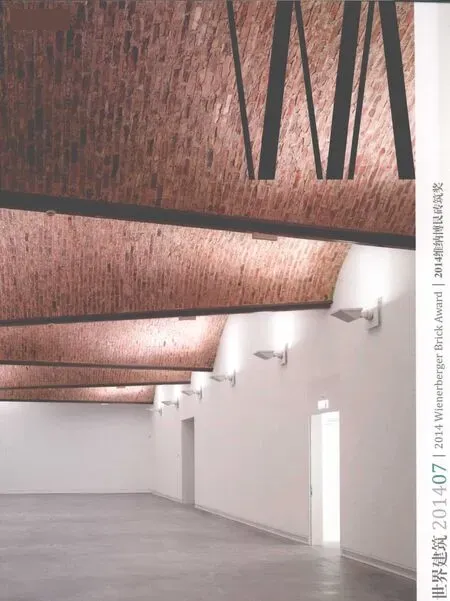阿斯特里古堡,阿斯特里,沃里克郡, 英国
建筑设计:威瑟福德—沃森—曼建筑事务所
阿斯特里古堡,阿斯特里,沃里克郡, 英国
建筑设计:威瑟福德—沃森—曼建筑事务所

1 外景/Exterior view
对于这座建筑来说,或许坐着马车或是至少开一辆老式宾利前往更为合适。位于沃里克郡的阿斯特里城堡距离莎士比亚的出生地埃文河畔斯特拉特福和工业城市伯明翰大约都是半小时左右的车程,这是座建于文艺复兴时期的早期哥特风格的建筑。建筑周边的护城河和部分庄园的建设可以追溯到13世纪,但建筑的主体建于1555年。
建筑坐落在有牛羊漫步其中的草地之上,仿佛是直接从油画中来到现实一般。这座美丽的庄园曾是许多名人的家,它过去的主人们包括爱德华四世、亨利七世和约克的伊丽莎白女王。经过数次转手之后,庄园建筑在1960年代被改建成酒店,并设有一间餐厅和一间酒吧。1978年4月3日,建筑被一场大火完全烧毁,之后则被废弃了几十年。
“建筑当时的状态很糟糕——早已成为了与自然融为一体的废墟”,阿拉斯泰尔·迪克—克莱兰,英国慈善机构地标信托的项目协调人回忆道。“我们从1995年就开始准备购买和重建阿斯特里城堡,但当时我们的资金还不充裕。”2005年,在信托成立40周年的同时,时机终于到来了。12个来自英国各地的建筑师被邀请来为这一历史建筑设计重新使用的可能性。以伦敦为中心开展业务的威瑟福德—沃森—曼建筑事务所(WWM)赢得了竞赛,他们设计的具有永恒特质的优雅的砖砌建筑矗立在长期被荒废的废墟之上,如同填上了陶瓷的义齿。
因为新建筑使用了碎石块、木色门框和上面覆盖苔藓的砂浆,从公园里的某些角度看,很难发现废墟中发生了任何变化。而从其他视点瞭望,新建的阿斯特里城堡混合使用当地的红色天然石材、旧砖和新的手工砖,呈现出柔和的拼贴画般的形式。建筑的新旧部分结合得非常巧妙,但还是可以明显区分开来。大型的木框窗中的一部分装设在与墙的内侧平齐的1.2m高处,另一部分则与外墙平齐,让人能察觉到新旧建筑的墙体之间细微的空间尺度变化。
“我们花了相当长的时间寻找合适的建材,”WWM的项目负责人弗雷迪·菲利普逊说,“此外,我们必须确保材料的颜色一致,同时砖要足够长和平整,以适应石墙不规则的边界,同时填充尽量少的砂浆。”每片墙的表面都使用了不同的节点式样。其中的美在于体现了不规则性中的规则。
新的阿斯特里城堡于2013年秋天获得了著名的英国皇家建筑师学会的斯特林奖,现在已经成为了建筑爱好者和所谓的公众人物们的奢华住处。建筑的建设费达到了250万英镑,约合300万欧元。其中最大的资金支持来自文化遗产彩票基金和通过英国古迹署的私人捐赠。虽然现在已经了无痕迹,建造的过程曾经非常艰辛,其中使用了大量的尖端技术,也得到了大量的沃里克郡的志愿者的参与。建筑中采用了地暖系统、精美的织物和体现出一丝皇家气息的内装饰,从建筑中可以欣赏周边的护城河、墓地和圣玛丽圣母教堂的美景。(司马蕾 译)
It would have been more fitting to arrive by horse-drawn carriage - or at the very least to pull up in a vintage Bentley. Astley Castle in Warwickshire, a half-hour's drive both from Shakespeare's birthplace of Stratford-upon-Avon and from the industrial city of Birmingham, is a throwback to the early Gothic and Renaissance periods. The moat and parts of the manor house date back to the 13th century, while the majority of the structure was built around 1555.
Nestled in the midst of sheep and horse meadows that seem to have been lifted straight out of an oil painting, this beautiful estate was once home to a number of famous people. Its list of former owners includes Edward IV, Henry VII and Queen Elizabeth of York. After changing hands numerous times, the manor house was converted into a hotel with a restaurant and pub in the 1960s. On 3 April 1978, the building was destroyed completely by fire, after which it stood abandoned for decades.
"The state of the building was deplorableit was a ruin that had long been reclaimed by nature," remembers Alastair Dick-Cleland, project coordinator for the British charity The Landmark Trust. "As far back as 1995, we were intending to buy and restore Astley Castle, but back then we lacked the money." In 2005, coinciding with the 40th anniversary of the trust, the time had come. Twelve architects from all over the UK were invited to submit ideas for a possible use of this historic place. The London-based firm Witherford Watson Mann Architects (WWM) emerged the winner with their design of a timelessly elegant brick building among long-decayed ruins like a ceramic tooth filling.
Seen from certain points in the park, it's hardly noticeable that a single stone was changed in the ruin, featuring as it does spalled rock, flamecharred door frames and moss-covered mortar. From other vantage points, revitalised Astley Castle appears as a gentle collage of red natural stone, old brickwork and new, hand-crafted facing bricks from the region. The temporal fault lines are subtle, but clearly visible. The large, wood-framed windows, some of which are flush with the inside edge of the 1.2-metre-deep reveal, others with the external edge of the facade, make the mighty spatial dimensions of the old and new masonry walls palpable.

2 庭院/Courtyard
"The search for a suitable building material took us a fairly long time," explains Freddie Phillipson, WWM project head. "On the one hand we had to make sure that the colour spectrum was right, on the other the brick had to be as long and flat as possible so as to allow the irregular connections to the stone masonry to be accomplished with as little mortar as possible." A different joint pattern was designed for every wall surface. The art lies in the regularity of the irregularity.
Awarded the renowned RIBA Stirling Prize in autumn 2013, Astley Castle is now let out as a luxury residence to architecture buffs and would-be dukes. The construction costs came to 2.5 million pounds, or just 3 million euros. The largest share of this came from the Heritage Lottery Fund and from English Heritage, supplemented by individual donations. Today, no evidence remains of the arduous building process, which involved a good deal of technical wizardry and even the labour of local Warwickshire volunteers. Floor heating, fine fabrics and a hint of royal flair characterise the interiors, which offer views of the moat, the cemetery and the church of St Mary the Virgin.
项目信息/Credits and Data
客户/Client: 地标信托/The Landmark Trust
建设周期/Construction Period: 2010 - 2012
建筑用途/Building's Purpose: 度假出租用房/Holiday house for rental
用砖类型/Brick Type: 面砖,粘土砖,粘土瓦/Facing bricks, clay blocks, clay floor tiles
摄影/Photos: Wienerberger AG/Philip Vile (Fig.1-3,5,6), Philipp Ebeling (Fig.4)

3 外景/Exterior view
评论
陆翔:对城堡废墟的改造像是空间和材料的拼贴:新砌筑的平整而细密的砖墙将崩塌的离散的石块墙体缝合,新的带有归属感的木质门窗与废墟中残留的略显悲怆的深陷洞口并置,原来的庄严的大厅变为接待客人的有墙无顶的室外平台。缝合中的一个技术性问题在于砖的选择,“砖要足够长和平整,以适应石墙不规则的边界,同时填充尽量少的砂浆”。
杨志疆:建筑使用砖木材料来精心缝合被大火“撕裂的伤口”,建筑师一方面有意在回避过于强烈的对比,另一方面又不想使存在多年的废墟形态被彻底消解掉。与考古学家的合作,使得新旧之间的断层清晰可见。虽然就整体观感而言,原有废墟的力度还是被削弱了不少,但精心打造的室内空间,却几乎随处都可以看到它们的存在。这些废墟的片段穿透几百年的时空,成为永远的伤口,无法愈合。那种感受还是略带伤感,使人不禁想去轻轻地抚摸。
Comments
LU Xiang: The transformation of the castle ruins resembles a spatial and material collage: the newly built, smooth brick walls have "sewed" together the disparate, broken down stone elements; wooden doors and windows are juxtaposed directly with deep, melodramatic holes of the ruins; the guest terrace, walled yet without rooftop, occupies the former stately hall. One of the key technical points for "sewing" is the choice of the brick: "[...] the brick had to be as long and flat as possible so as to allow the irregular connections to the stone masonry to be accomplished with as little mortar as possible."
YANG Zhijiang: Brick was the material chosen to be used on this building in order to carefully stitch the "tearing wound" caused by a fire. The architects intentionally avoided strong contrast. They didn't want to undermine the form of the ruins completely. In collaboration with archaeologists, the difference between the new and the old is clearly visible. In terms of overall perception, the intensity of original ruins has been weakened. But they can still be seen almost everywhere in the carefully crafted interior spaces. The remaining fragments of the ruins penetrate through several hundred years of time and space. They are eternal wounds that can never heal. This slight sad feeling still makes people want to gently stroke the surface of the architecture.
Astley Castle, Astley, Warwickshire, United Kingdom, 2012
Architects: Witherford Watson Mann Architects

4 内景/Interior view

5 细部/Detail

6 入口/Entrance

7 平面/Floor plan

8 细部/Detail

